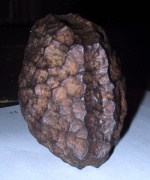This article needs additional citations for verification. (September 2014) |

The Wolfsegg Iron, also known as the Salzburg Cube, is a small cuboid mass of iron that was found buried in Tertiary lignite in Wolfsegg am Hausruck, Austria, in 1885.[1] It weighs 785 grams (1 lb 12 oz) and measures 67 mm × 67 mm × 47 mm (2¾" x 2¾" x 1¾"). Four of its sides are roughly flat, while the two remaining sides (opposite each other) are convex. A fairly deep groove is incised all the way around the object, about mid-way up its height.[2][3]
The Wolfsegg Iron became notable when it was claimed to be an out-of-place artifact: a worked iron cube found buried in a 20-million-year-old coal seam. It was originally identified by scientists as being of meteoric origin,[2] a suggestion later ruled out by analysis.[citation needed] It seems most likely that it is a piece of cast iron used as ballast in mining machinery, deposited during mining efforts before it was found apparently within the seam.[citation needed]
- ^ Grady, Monica M.; A. L. Graham (2000). Catalogue of Meteorites: with special reference to those represented in the collection of the Natural History Museum, London. Cambridge University Press. p. 529. ISBN 0-521-66303-2.
- ^ a b Cite error: The named reference
Naturewas invoked but never defined (see the help page). - ^ Cite error: The named reference
L'Astronomiewas invoked but never defined (see the help page).